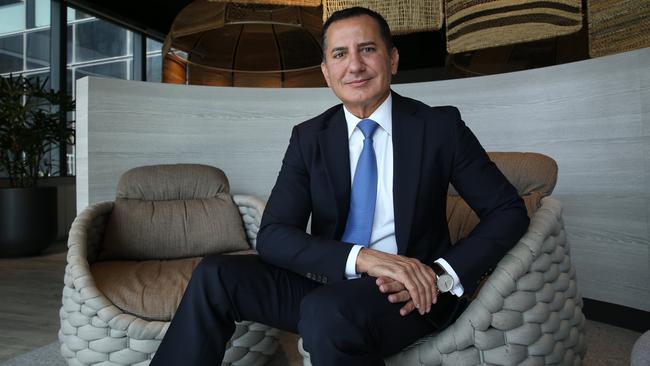
The regional banks already have a spate of challenges this year, and that’s without $281 billion giant China Construction Bank running the rule.
This column understands China Construction has had a group of operatives in Australia recently doing preliminary work on acquiring a second-tier bank or shaking loose the banking operations of Suncorp or AMP.
The early work — investment banks are yet to be appointed — comes as the Hayne royal commission dust starts to settle and the smaller banks navigate a tough earnings environment.
China Construction isn’t a stranger to Australia. It has a banking licence here and largely operates in the corporate space with gross loans and advances of about $4.6bn. Three years ago it acquired Royal Bank of Scotland’s Australian corporate and project infrastructure loan book.
The Chinese bank has also made overtures to at least one large non-bank lender over the past two years.
And, while the heavyweight has a lower price-to-book ratio than regionals such as Bendigo and Adelaide Bank and Bank of Queensland, one thing it’s not short of is cash and liquid assets.
An acquisition of a second-tier bank in Australia would be a small bolt-on for a company the size of China Construction, so one would have to wonder whether a bigger strategy is at play.
But the Foreign Investment Review Board would obviously need to green light any deal, which would be easier at the smaller end of the market.
China’s authorities last year changed their focus from containing the nation’s debt pile to shoring up economic growth.
Locally, slowing credit growth and higher compliance and technology costs have investors in regional banks once again talking up marriages between them. Investment bank advisers are scrambling to stay close to Bendigo Bank and Bank of Queensland in case formal defence or other strategic deal mandates are there to be handed out.
Suncorp already has a longstanding relationship with UBS.
Chairmen are changing over at Bendigo Bank and BoQ, which also just appointed a new chief executive in George Frazis.
Suncorp has only just kicked off a CEO search for departing Michael Cameron.
So the deck chairs are certainly shifting and that may awaken any deal discussions.
Counting the costs
Commonwealth Bank and its investors are wearing the pain of the failed foray into financial advice, but some responsibility has to sit with the investment bank that assisted on the way in.
Goldman Sachs advised CBA on the $373 million Count Financial deal as many of the banks were pushing into what they believed would provide a diversified future growth engine.
When the transaction was signed, the Count offer equated to 14.6 times 2011 normalised net profit after tax of $25.6m.
The whitewash that was CBA’s $2.5m Count sale yesterday, alongside a $200m indemnity to acquirer CountPlus, shows the scale of value destruction. The sale sees CBA jettison a now loss-making business.
A CBA demerger of its other unloved planning unit, Financial Wisdom, alongside Colonial First State, broking house Aussie Home Loans and a 16 per cent stake in Mortgage Choice looks more unlikely by the day.
Mortgage moves
Is differential mortgage pricing, depending on the size of your deposit, about to hit the Australian market in a big way?
It’s already been quietly rolled out at Westpac-owned St George Bank for the bulk of the bank’s home and investor loans. From late last month, St George introduced changes that will have the other large banks sitting up and taking notice.
The concept is simple: the bigger the deposit, the larger the discount on the interest rate.
For customers borrowing between 60 per cent and 80 per cent of the value of their property, the discounts stands at 0.05 per cent on their home loan rate.
Customers borrowing 60 per cent or less of the value of their property are eligible for a discount of 0.1 per cent.
“These changes have made St George’s home loan offers more transparent and competitive for our customers,” St George general manager Ross Miller told this column.
It will be interesting to see how the decision — which sources said was also made to help fend off competition from foreign banks HSBC and ING, which were making strong inroads in the mortgage market — plays out.
It came ahead of the Australian Prudential Regulation Authority’s new proposed changes to loan risk weights for mortgages deemed more risky, such as investor and interest-only.
The higher thresholds for riskier loans ensures there will have different cost dynamics than vanilla owner-occupied loans that pay principal and interest. The planned APRA measures aren’t due to start, though, until 2022.
Differential or risk-based pricing has been used for some time by non-bank lender Pepper, but it looks at the deposit size and a borrowers’ credit performance to assess a risk fee.
ING tried to introduce differential pricing in 2012, but the measure was reversed.
“We will eventually see more of that (differential pricing),” a senior industry player tipped.
Westpac and its big bank brethren appear to be getting more defensive about the strong growth of players, including HSBC, in the post-royal commission landscape.
The latest APRA data for April has HSBC’s total housing loan growth at a bumper 37 per cent versus the same month last year.
HSBC has sought to increase its physical presence and re-enter the broker channel over the past two years.



